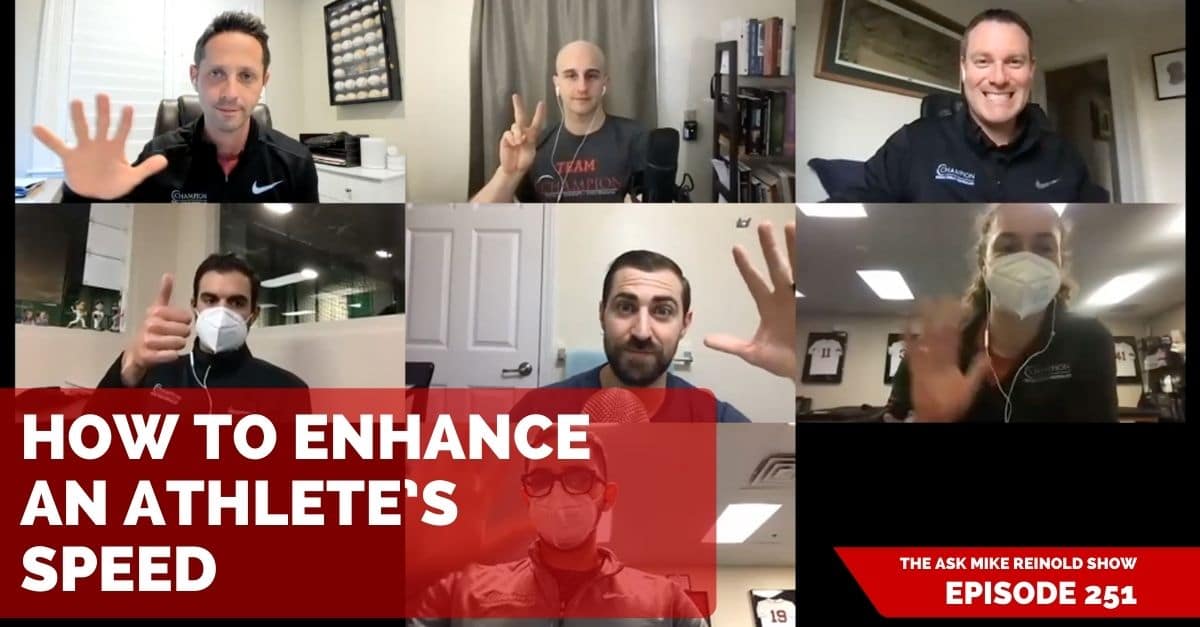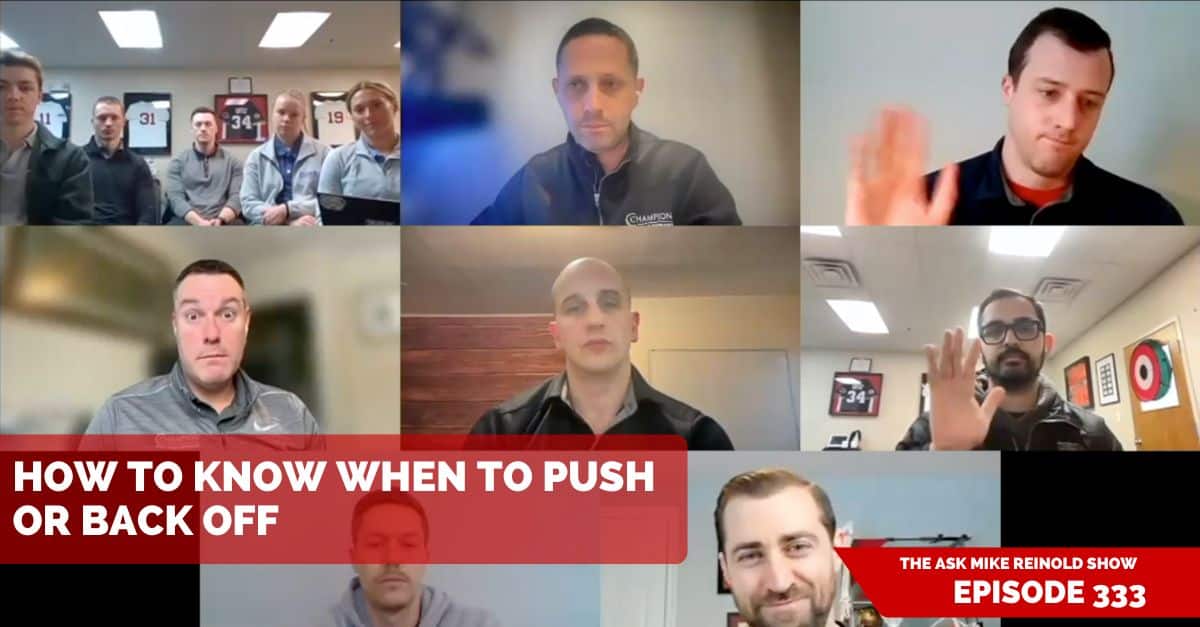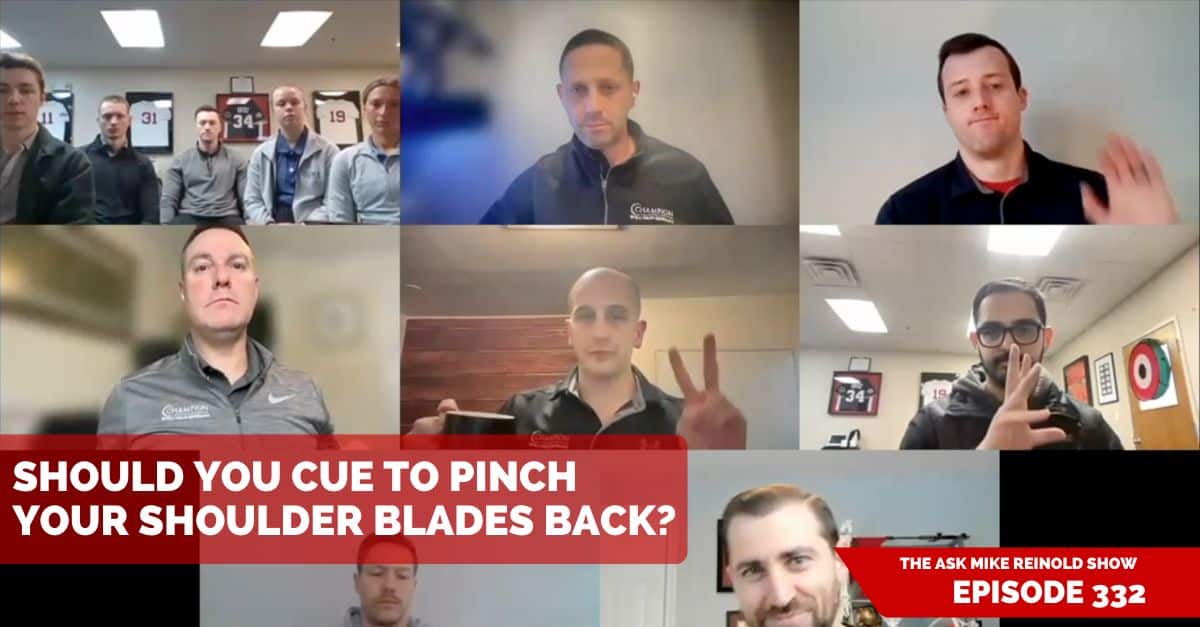Most athletes want to get faster. I’ve seen many people say that to get faster, you just need to get stronger and more powerful, while others think focusing on technique and form is the key.
Here’s how we enhance speed in our athletes at Champion.
To view more episodes, subscribe, and ask your questions, go to mikereinold.com/askmikereinold.
#AskMikeReinold Episode 251: How to Enhance an Athlete’s Speed
Listen and Subscribe to Podcast
You can use the player below to listen to the podcast or subscribe. If you are enjoying the podcast, PLEASE click here to leave us a review in iTunes, it will really mean a lot to us. THANKS!
Show Notes
Transcript
Mike Reinold:
So this week, for our amazing question, because we have an amazing question this week, this one comes from George from Utah. George says … We don’t get a lot of people from Utah, by the way, right? We should start keeping track of which states we get people from. I like it. Oh, Diwesh, by the way, is already un-muted and ready to unleash.
Diwesh Poudyal:
[inaudible 00:01:14].
Mike Reinold:
He’s ready to unleash. Let’s see, George from Utah says, “Hey, Champion. One thing I’ve tried to research more lately was how to improve speed in my athletes. I see many people work on form and technique while others say speed is just a result of strength and power. How does Champion improve their athletes’ speed? I like this question, right? And Diwesh and I kind of talked about this a little bit when it kind of came in a little bit, but I like this question. I think that’s actually a pretty solid debate that we’re seeing online a little bit here is, is speed just like a technique and a form type thing, or is it really just a correlation between how strong and powerful somebody is?
Mike Reinold:
And, I mean, if you’ve been listening to our show long enough, right, you know that we never say it’s one, right? The answer is almost always going to be, “Both, to an extent.” Right? So I already gave you the answer a little bit, but good question there, George.
Mike Reinold:
So Diwesh, obviously, why don’t you start this off? Diwesh kind of runs our sports performance stuff at Champions, so I think he’s probably the most in tune with this sort of stuff and then, and take it away, I guess, from there, Diwesh.
Diwesh Poudyal:
Yeah. So to start, I think, reiterating what Mike said, it’s often both, right? We kind of have the same discussion with the soft tissue work and the loading and all that stuff all the time. But I think in this case, it’s also both.
Diwesh Poudyal:
Now, with that said, we’ve always got to think specificity. If you’re trying to get an athlete really, really fast, and the end goal is speed, right, the focus of the program does have to be on sprinting, running, right? If we’re talking multi-directional speed, it’s got to be on change of direction. So practicing, it is probably going to be a bigger benefit than maybe even some of the strength and power stuff, right?
Diwesh Poudyal:
So that’s one thing that we can’t forget. We know that getting stronger, being more powerful, it can definitely impact speed quite a bit, but if you’re never running, right, it’s hard to say that you’re going to get faster, right?
Diwesh Poudyal:
So I think that’s one thing to consider. Now, with that said, the way that I kind of think about improving speed in my head is it’s three categories of things, right? I put a ton of emphasis on positions and posture, put a ton of emphasis on power, and I put a ton of emphasis on practice. So those are my three Ps and …
Mike Reinold:
I was going to say, I think I see where you’re going with this there. Those are a lot of Ps in those words.
Diwesh Poudyal:
Yeah.
Mike Reinold:
Yeah.
Diwesh Poudyal:
So that’s just one way that I like to, that I like to simplify the process, right? Because we do know that posture is really, really key. We have distinct phases of speed. We have an acceleration phase, we have top end sprinting mechanics that will look fairly differently as far as positions and postures go. So I made sure that I have athletes understand and kept track to stand on all these positions, understand some more of the key differences. We know that acceleration is solely more ground contact time. It actually requires a little bit more strength to get going, because you’ve got to push into the ground for a little bit longer, whereas the top end sprinting mechanics is a little bit more elastic in nature. You’re kind of cycling a little bit quicker, stride frequency’s higher, while stride length is also pretty long, whereas on acceleration, the stride length is long, but you’re actually pushing into the ground for quite a bit longer, right?
Diwesh Poudyal:
So we do know that in these instances, you need to be powerful, you need to be strong, right? So we do train our athletes to be powerful and strong. So, again, to answer the question in a holistic sense, a lot of emphasis on strength and power, so that they have the baseline capability of being fast. Just think about raising that floor up for the athlete or even really raising the ceiling up, right, if we’re talking about what’s like the end goal or what’s the max speed that they can achieve, right? You can probably get them really fast just by doing sprinting work and just by doing position work and practicing. But if we can improve their strength and power, they’ll probably have a higher ceiling to potentially get faster than they would if there was no strength training involved whatsoever.
Mike Reinold:
I like that. And it’s funny too, for some reason, sprinting and speed work, people don’t think of any other sport activity. So let’s say like baseball pitching philosophy, right? That’s like, do we work on strength and conditioning or do we just work on pitching mechanics lessons, right? The answer is almost always both, right? You want to be as strong and powerful as you can be with efficient mechanics that are related to increasing your output, right? And there’s lots of ways you can sprint poorly, right, that you can have more form that maybe limiting your speed, right? But also I think we also like to think you’re probably not maximizing your speed if you’re not maximizing your strength and your power, right?
Diwesh Poudyal:
Yeah.
Mike Reinold:
So it’s kind of interesting to kind of put it that way. I think a lot of people say that, but it’s funny, how many times have we had parents contact us or ask us and say like, “Hey, you know, I want to get my kid on a, you know, do you guys do like a speed camp?” Right? Why do parents want to do speed camps? That’s like the biggest thing, like, “Do you guys do speed and agility work?” And it’s like, “Well, your kid’s 12, right?” Like, he’s … Like, I don’t know, I don’t know if I was doing ladder drills and stuff, but it’s like, that’s what the parents think is the most appropriate thing for them.
Mike Reinold:
So I don’t know, why don’t you touch on that just briefly, Diwey, because that’s, I think, the answer to George’s question, right, is to work on a little bit of both, right? But how do we educate the parents that come to us? Is there anything that you say or is it just explaining what you did?
Diwesh Poudyal:
Yeah, no, I definitely do think there’s a big education component to it. I think it’s fairly easy for an athlete or a parent to just kind of assume like, all right, here’s kind of what I see everyone doing to get faster, they do all these fancy drills, they do all these things that look like speed, they, you know, it looks like quick feet and they assume that that’s what’s equating to speed, right? So all we got to do is we’ve got to just kind of get their understanding to be a little bit different where we explain to them, “All right, here’s what acceleration or picking up speed looks like right? Here’s what, once you pick up speed, here’s what maintaining that top end speed looks like. Here’s how you changed direction a little bit more efficiently.” If we can start getting them to understand some like the key component parts, and then we start explaining how we work on those component parts separately, and then put it all together as a whole, I think they can get a better understanding, right?
Mike Reinold:
Yeah.
Diwesh Poudyal:
So typically if I have an athlete or a parent that’s really focused on speed and that’s all they want and that’s all they care about when they come in to this facility, I say, “Hey, listen, we’re going to work on all those things”, right? We’re going to make sure that your athlete understands all the positions. They’re going to get a lot of practice in actually being fast and running fast, right, and get the exposure for it, but we know that let’s say we have athlete A and athlete B. They both have really, really good technique, right? What’s the thing that’s going to separate them out? That’s going to be how powerful they are as an athlete, right? So I get them an understanding of you do work on that power component so that you’re going to be able to get yourself to have higher potential as an athlete, and not just simply come in here and do fast feet, the ladder stuff and whatever …
Mike Reinold:
I like that.
Diwesh Poudyal:
Whatever else is fancy.
Mike Reinold:
And I’d share too, just like from our biomechanical work with some of the stuff we’ve done at the lab at AS Meyer, even now with the White Sox we’re doing with our lab that we’re doing there is if we’re looking at force production output in what we’re trying to do, so if you’re a strength coach, physical therapist working on that, most of it is hip extension and then ankle plantar flection, right? So keep that in mind, right, when you want to start building programs, it’s hip extension and ankle plantar flection. I think we always go straight to the knee, right, when we talk about sprinting. Well, I mean, you guys probably don’t, but maybe I did at one point in my life, right, but it’s not about how fast you can drive up, it’s about how fast you can drive down, right? And then kind of explode off it. It’s a very interesting thing.
Mike Reinold:
So when you’re building programs, it’s hip extension and plantar flection, strength and power. I think that’s a really important kind of factor to consider with speed and even probably just agility with everything.
Mike Reinold:
So, I don’t know. This is a big topic, right? So I think George gets that. I think George gets a little bit of his understanding that you need to be strong and powerful, but we need to do some form. Sprint form isn’t something we learn, right? As physical therapists, we don’t learn it at all, of course. As strength and conditioning coaches, I would assume, you know, I didn’t learn it into my preparation in there. Diwesh, what do you think’s a great resource that you could maybe share with people that you think helped you understand a little bit of those three Ps that you came up with, but really the ones related to your form in that aspect of strength, speed and agility?
Diwesh Poudyal:
Yeah. My two go-to resources for speed stuff is definitely Derek Hansen. He talks a lot about linear speed. So he’s a big track coach. He does a lot of consulting with NFL teams and NBA teams and stuff. He’s sort of a really good one to learn just linear speed, really gain understanding, right? He’s taken a lot of Charlie Francis’ work. He’s a big time name in the strength and conditioning industry, and has done a lot of sprint work. So he’s my favorite for linear.
Diwesh Poudyal:
For change of direction or lateral speed, Lee Task is another guy that I really look up to and tend to pick up a lot of stuff from. So if you just follow those guys and follow maybe some of the other people that they follow, you’re probably going to get a pretty good amount of information on how to learn more about speed and posture, positions …
Mike Reinold:
Yeah.
Diwesh Poudyal:
And all the practice and programming too.
Mike Reinold:
Yeah, and I think they all have a bunch of good resources too, for like educational stuff too, that they can pick up on. So awesome. Great stuff. I feel faster already, I don’t know about you guys. So I think that, I think that was a success, successful episode. That was good. We probably have the longest duration of mutes from the physical therapists on their Zoom calls during this, but I like it. Good stuff. Diwesh, I appreciate it. If you have a question like George, please head to mikereinold.com, click on that podcast link and we’d love to answer away anything you want to talk about, just ask in that form and we’ll get to it on a future episode. Thank you so much.





